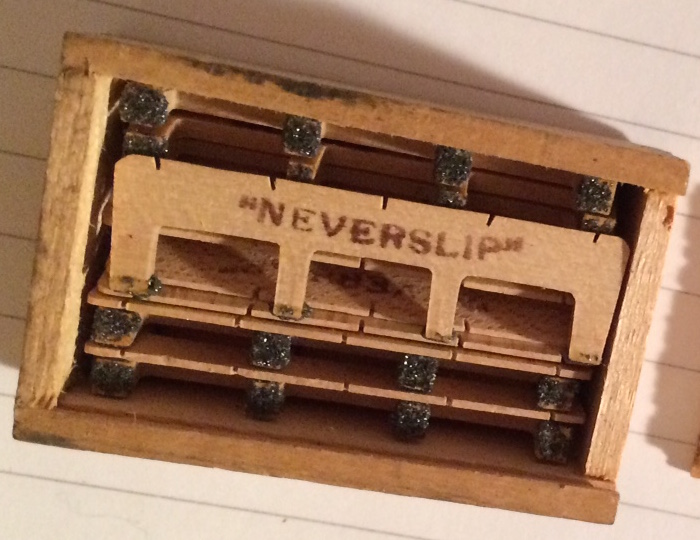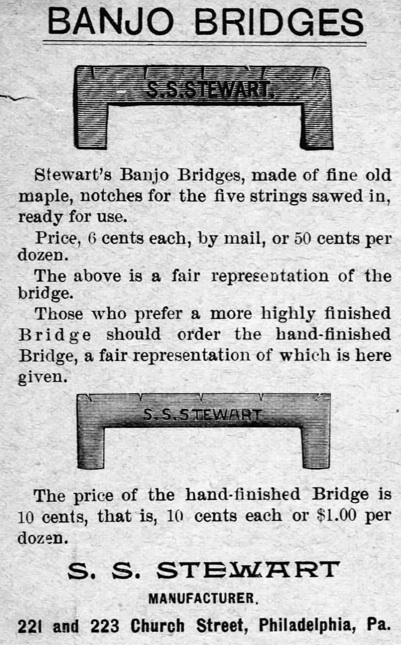Classic-Banjo
A Site Dedicated to all enthusiasts of Classic Style Banjo
Gear question(s)
I recently switched my standard 5-string over to nylon strings, and I LOVE it - I'll never go back! Of course now I'm running into some issues and have finally decided I need to bring it to y'all for some advice and counsel.
First of all, I've been breaking strings at an unaccustomed rate (a quality-of-life issue for me, as I'm notoriously lazy about string-changing!). One thing was, I realized that the standard bluegrass-style banjo scale of 26 1/4" (66+ cm) is significantly longer than classical guitar scale. So question #1 is: is there a standard CB scale length?
The other remedy i tried was a new tailpiece - I switched over to a no-knot, but rather than no knots, I have to use three different knots to get strings on there properly, and the 5th string is padded with a foam earplug. And now - I guess due to lower tension behind the bridge - I keep pulling the 1st string out of the bridge slot. I solved this problem by putting a small piece of duct tape-wrapped dowel between the first and second strings behind the bridge, probably giving up some resonance in the bargain. And you can imagine how the back end of my banjo is a bit of a mess at this point.
One of you has very kindly offered to make me a wood Waverly-style tailpiece and bridge, which may solve various issues (including the aesthetics!) though I may have to have an endpin/button thingy installed, I haven't explored that yet.
So I can at least make the gig on this thing, but maybe I need a new neck entirely, or maaaayyyybeeee I have an excuse to go out and get a whole new banjo! :o)
thanks all!
Tags:
Replies to This Discussion
-
Permalink Reply by Jody Stecher on March 14, 2016 at 15:40
-
Jocko, most banjos work perfectly well with nylon strings with no adjustments made at all. The so called No Knot tailpiece is not a good tailpiece. It has rough edges and it breaks nylon strings. Go back to your original tailpiece. Many banjos that were built for classic banjo playing had similar tailpieces that applied downward pressure. Thousands of Clifford Essex banjos had this feature for instance. There is no standard string length for classic banjo just as there is no standard string length for bluegrass banjo. Gibson didn't even have a standard length. your comment about classical guitar scale makes me wonder if you are using strings from a classical guitar set. That would be far too heavy and of course strings will break. A bowline is a good knot for nylon strings. Instructions for tying a bowline for nylon instrument strings can be found here: http://zeppmusic.com//bowline.htm
-
Permalink Reply by Jocko MacNelly on March 14, 2016 at 17:28
-
Hi Jody! You got that right about the strings. Where can I find a proper set besides freeloading off of Ian? He likes the hard tension, I think I probably need to step it down to medium, but I can't find where to order them unless I get Nylguts, and they seem to be too temperamental (though they're great on my uke!). Maybe something other than the reds will be ok. (though the Nylgut reds look so cool! :o)
I changed the tailpiece because those edges on my original one seemed to be problematic but yeah, I might try it again. Yup, been using a bowline where I could, the problem with all the knots is just that the posts on the no-knot are too crowded - it's too small for nylon strings.
thanks man, hope all is well.
-
Permalink Reply by Jody Stecher on March 14, 2016 at 17:44
-
If you use nylon strings of the gauges intended for five -string banjo either of your tailpieces will have ample room for knots. Plain ol regular Aqulia nylgut banjo strings are *not* more temperamental than nylon or gut. During the first 24 hours they will need to be re-tuned every few hours. that's all. Same for nylon, same for gut, same for PVF, same for fishing leader. There are literally dozens of choices and dozens of places to obtain strings. Try Strings By Mail or Elderly or eBay or JustStrings or ….well the list is …"Yuge" .(to quote Candidate Bernie). If you can't make up your mind just order some Chris Sands medium or heavy strings from Elderly. Best shipping rate though is from Strings By Mail. It's $4 if you order 1 sting or 50 sets. good deal. About hard tension or heavy gauge, the banjo sets that are packaged as such are only heavy relatively speaking. It's nothing like Flamenco guitar strings. A "heavy" Chris Sands set will feel no heavier than a typical light gauge set of metal bluegrass banjo strings.
Jocko MacNelly said:Hi Jody! You got that right about the strings. Where can I find a proper set besides freeloading off of Ian? He likes the hard tension, I think I probably need to step it down to medium, but I can't find where to order them unless I get Nylguts, and they seem to be too temperamental (though they're great on my uke!). Maybe something other than the reds will be ok. (though the Nylgut reds look so cool! :o)
I changed the tailpiece because those edges on my original one seemed to be problematic but yeah, I might try it again. Yup, been using a bowline where I could, the problem with all the knots is just that the posts on the no-knot are too crowded - it's too small for nylon strings.
thanks man, hope all is well.
-
Permalink Reply by Jocko MacNelly on March 14, 2016 at 18:12
-
Elderly! hadn't thought of them. Juststrings has been a go-to for a while. This at least will be a lot less expensive than experimenting with upright strings!
-
Permalink Reply by Joel Hooks on March 14, 2016 at 23:27
-
Hi Jocko, Jody was not kidding-- guitar strings are HUGE compared to banjo strings.
D'Dddario normal tension first = .028
Classic era gut, silk and early nylon firsts = .016 (that is what FVE used too).
That is a very big difference.
I go against the recent trend of thick and heavy strings. With large strings I lose energy to torque. The thick strings roll instead of snapping to vibrate. Think of it like a log rolling vs clicking the edge of a piece of paper. I get better results with less effort using light hard strings. I like the Labella No 17s (though even those have gotten thicker recently).
First thing to do. Go to an auto parts store and buy some wet/dry 1500 and 2000 grit sandpaper. Take your old tailpiece and get a small bowl of water. Put on a good movie. Then tear off small pieces of the sand paper, dip it in the water and polish anywhere that a string might touch. Even a presto will work fine once "cleaned" of burrs. Kershner tailpieces were designed for gut and the modern ones work great. I can also recommend the "Colby" Van Eps (sort of) tailpieces. Get it directly from John Pierce Strings as they make one with a longer bolt. Fantastic pieces!
Next, your bridge problem. Are you a member of the ABF? If you are then read my article on bridges in the last issue. If not-- join!
You are likely using a bridge designed for wire strings. The notches are cut at a 90 degree angle to the top of the bridge. They are also too shallow. Proper notches for classic style should like like the photos below. Notice that they are cut at an angle. That matches the way your fingers strike the strings. Cut this way you will never pull a sting out of the notch.
-
Permalink Reply by Jocko MacNelly on March 15, 2016 at 16:09
-
Joel thanks, this is great info. You rock!! Yeah I'll check your article, see you at ABF.
-
Permalink Reply by thereallyniceman on March 15, 2016 at 16:34
-
Hi Jocko,
Great to see you back on here! So now you prefer nylons?... oh, strings you mean :-)
As you will now know, they feel better and sound better than steel strings especially for Classic Style. I use Heavy strings (I prefer Clifford Essex nowadays) when I have not played for a while. They build up the fingertip segs quickly and sound snappy, but can as Joel says, require more effort. This seems much more noticeable on thicker vellums or heads! Using heavy gauge nylon strings and a Remo Fibreskin head and you really have to do some work with your fingers... and I have never really worked out why!
Most of my playing now uses CE Medium nylons, which play a little easier, but I really don't like light gauge strings as they seem to move about too much for me and sound a bit "thin" too, but maybe I pick too hard?
Can't wait for the next video with your nylons!!
Ian
-
Permalink Reply by Jocko MacNelly on March 15, 2016 at 18:42
-
(rimshot!) :o)
-
Permalink Reply by Jocko MacNelly on March 15, 2016 at 22:35
-
Permalink Reply by John Cohen on March 17, 2016 at 0:50
-
Just to add my 2 cents, original no-knot tailpieces work perfect with gut and nylon. Some of the reproductions are made more cheaply and have burrs in the grooves that cause string breakage.
-
Permalink Reply by Jocko MacNelly on March 17, 2016 at 5:28
-
Yeah John, I'm gonna try Joel's sandpaper thing (on another tp!).
-
Permalink Reply by Jocko MacNelly on March 29, 2016 at 22:31
-
OK the heck with it, I'm taking it to a banjo tech! I put on light strings, changed the tailpiece back, it was sounding and feeling great, and I was JUST ABOUT TO post the after picture when...
- Attachments:
-
-
 image.jpeg, 1.2 MB
image.jpeg, 1.2 MB
-
© 2025 Created by thereallyniceman.
Powered by
![]()

